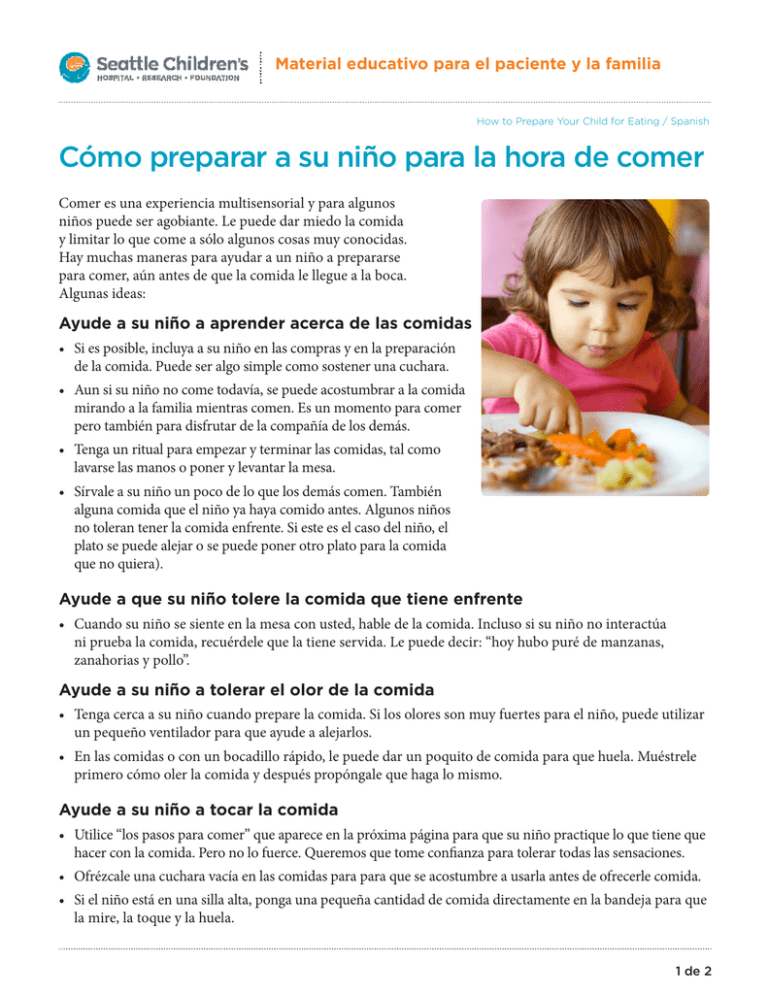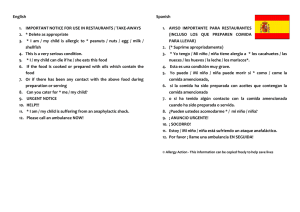PE1107S How to Prepare Your Child for Eating - Spanish
Anuncio

Material educativo para el paciente y la familia How to Prepare Your Child for Eating / Spanish Cómo preparar a su niño para la hora de comer Comer es una experiencia multisensorial y para algunos niños puede ser agobiante. Le puede dar miedo la comida y limitar lo que come a sólo algunos cosas muy conocidas. Hay muchas maneras para ayudar a un niño a prepararse para comer, aún antes de que la comida le llegue a la boca. Algunas ideas: Ayude a su niño a aprender acerca de las comidas • Si es posible, incluya a su niño en las compras y en la preparación de la comida. Puede ser algo simple como sostener una cuchara. • Aun si su niño no come todavía, se puede acostumbrar a la comida mirando a la familia mientras comen. Es un momento para comer pero también para disfrutar de la compañía de los demás. • Tenga un ritual para empezar y terminar las comidas, tal como lavarse las manos o poner y levantar la mesa. • Sírvale a su niño un poco de lo que los demás comen. También alguna comida que el niño ya haya comido antes. Algunos niños no toleran tener la comida enfrente. Si este es el caso del niño, el plato se puede alejar o se puede poner otro plato para la comida que no quiera). Ayude a que su niño tolere la comida que tiene enfrente • Cuando su niño se siente en la mesa con usted, hable de la comida. Incluso si su niño no interactúa ni prueba la comida, recuérdele que la tiene servida. Le puede decir: “hoy hubo puré de manzanas, zanahorias y pollo”. Ayude a su niño a tolerar el olor de la comida • Tenga cerca a su niño cuando prepare la comida. Si los olores son muy fuertes para el niño, puede utilizar un pequeño ventilador para que ayude a alejarlos. • En las comidas o con un bocadillo rápido, le puede dar un poquito de comida para que huela. Muéstrele primero cómo oler la comida y después propóngale que haga lo mismo. Ayude a su niño a tocar la comida • Utilice “los pasos para comer” que aparece en la próxima página para que su niño practique lo que tiene que hacer con la comida. Pero no lo fuerce. Queremos que tome confianza para tolerar todas las sensaciones. • Ofrézcale una cuchara vacía en las comidas para para que se acostumbre a usarla antes de ofrecerle comida. • Si el niño está en una silla alta, ponga una pequeña cantidad de comida directamente en la bandeja para que la mire, la toque y la huela. 1 de 2 Tratamiento para la sensibilidad motriz antes de comer Para más información Antes de comer • Terapia Física y Ocupacional 206-987-8448 • www.seattlechildrens.org 1 Tolera • • • • • Estar en la misma lugar En la mesa con la comida en la punta opuesta En la mesa con la comida en el centro En la mesa con la comida casi enfrente del niño Tiene la comida directamente enfrente y la mira 2 Participa Servicio gratuito de intérprete. • En el hospital, solicítelo a la enfermera de su hijo. • Fuera del hospital, llame a la línea gratuita de interpretación 1-866-583-1527. Dígale al intérprete el nombre de la persona o la extensión que necesita. • Para personas sordas y con problemas de audición: 206-987-2280 (TTY). • A yuda a preparar o servir la comida • Usa utensilios o un envase para mezclar o servir la comida o la bebida • Usa utensilios o un envase para servirse 3 Huele • • • • lores en el ambiente O Olores en la mesa Olores directamente enfrente del niño Se acerca y agarra y huele la comida 4 Toca • • • • • on la yema de los dedos o almohadillas para los dedos C Con la mano entera Con los labios Con los dientes Con la punta de la lengua o la lengua entera 5 Prueba • • • • • • S e chupa los labios, lame la comida Muerde pedazos y los escupe inmediatamente Muerde pedazos, los sostiene por un tiempo en la boca y los escupe Muerde, mastica por un tiempo y escupe Mastica y traga parcialmente Mastica y traga la comida con una bebida 6 Come Seattle Children’s ofrece servicios gratis de interpretación para pacientes, miembros de la familia y representantes legales sordos, con problemas de audición o con dominio limitado del inglés. Seattle Children’s pondrá a disposición esta información en formatos alternativos bajo solicitud. Por favor llame al Centro de recursos para las familias al 206-987-2201. Este volante fue revisado por personal clínico de Seattle Children’s. Sin embargo, las necesidades de su niño son únicas. Antes de actuar o depender de esta información, por favor consúltelo con el proveedor de atención médica de su niño. © 2010, 2014 Seattle Children’s, Seattle, Washington. Derechos reservados. Fisioterapia y Ergoterapia 5/14 PE1107S Tr: (mgh/lv) 2 de 2 Patient and Family Education How to Prepare Your Child for Eating Feeding is a multi-sensory experience and can be overwhelming for some children. They may be fearful of food and may limit what they eat to just a few familiar foods. There are a lot of ways we can help a child prepare for eating, even before any food gets to the mouth. Here are a few ideas. Help your child learn about mealtimes • If possible, include your child in shopping and any food preparation. This can be as simple as holding a spoon. • Even if your child isn’t eating food yet, they can become more comfortable with food by watching family members eat. Mealtimes are about eating, but they are also a time to enjoy each others company. • Have a beginning and ending ritual to meals, like washing hands, and setting and cleaning the table. • Serve food family style with everyone passing the food and serving themselves. Help your child to serve food onto their plate. (Some children do not tolerate food directly in front of them. If this is the case, your child’s plate can be pushed back or a small second plate can be used for nonpreferred foods.) Help your child tolerate food in front of them • When your child is sitting at the table with you, talk about the food. Even if your child does not interact or taste the food, remind them what was served. You can say, “We had applesauce, carrots and chicken for dinner.” Help your child tolerate the smell of food • Have your child nearby during food preparation. If the smells are overwhelming for your child, you can use a small fan that will help move the smell away. • At meals or snacks, bring a small amount of food up to your child to smell. Model how to smell the food first and then offer your child to take a turn. Help your child tolerate the touch of food • Please use the “Steps to Eating” on the next page to help your child practice interacting with food. Please don’t force your child. We want to build trust with them as they tolerate all of the sensations. • Offer an empty spoon at meals for a child to get use to the spoon before any food is offered. • If you child is in a highchair, put a small amount of food directly on the tray for him to look at, touch and smell. 1 of 2 How to Prepare Your Child for Eating To Learn More •Occupational and Physical Therapy 206-987-2113 •www.seattlechildrens.org Steps to Eating 1 Tolerates • • • • • Being in the same room Being at the table with the food on the other side of the table Being at the table with the food halfway across the table Being at the table with the food approximately in front of child Looks at food when directly in front of food 2 Interacts with Free Interpreter Services • In the hospital, ask your child’s nurse. • From outside the hospital, call the toll-free Family Interpreting Line 1-866-583-1527. Tell the interpreter the name or extension you need. • For Deaf and hard of hearing callers: 206-987-2280 (TTY). • Helps prepare/set up food • Uses utensils or a container to stir or pour food/drink • Uses utensils or a container to serve self 3 Smells • • • • Odor in room Odor at table Odor directly in front of child Leans down or picks up to smell 4 Touches • • • • • Fingertips, fingerpads Whole hand Lips Teeth Tip of tongue, full tongue 5 Tastes • • • • • • Licks lips, tongue licks food Bites off piece & spits out immediately Bites pieces, holds in mouth for “x” seconds & spits out Bites, chews “x” times & spits out Chews, partially swallows Chews, swallows with drink 6 Eats Seattle Children’s offers interpreter services for Deaf, hard of hearing or non-English speaking patients, family members and legal representatives free of charge. Seattle Children’s will make this information available in alternate formats upon request. Call the Family Resource Center at 206-987-2201. This handout has been reviewed by clinical staff at Seattle Children’s. However, your child’s needs are unique. Before you act or rely upon this information, please talk with your child’s healthcare provider. © 2010, 2014 Seattle Children’s, Seattle, Washington. All rights reserved. Occupational and Physical Therapy 5/14 PE1107 2 of 2
